

Can an Awards Show Solve Fashion's Sustainability Challenge? MILAN, Italy — Second only to oil, fashion is one of the world’s most polluting industries.

Practically every stage in the life cycle of clothing has negative implications for our planet. And if the world’s population rises to 8.5 billion people by 2030, as expected by the United Nations, overall apparel consumption will rise by 63 percent, from 62 million tonnes today to 102 million tonnes in 2030, significantly amplifying the scale of the problem, according to a recent report by the Boston Consulting Group and Global Fashion Agenda, a forum on fashion and sustainability. “We are aware that there are already many fashion awards, some of them even nod to sustainability. But what was missing at this level — by which we mean the global fashion stage — was something that celebrated provenance, sustainable innovation and the work that is being done in the supply chain to preserve sustainable production and innovate towards a lesser footprint,” explains Firth.
THE FUTURE OF LUXURY. Forbes Most Valuable Fashion Brands 2017. World's Top 10 Best Luxury Brands 2017 List, Highest Seller. Luxury brands are loved by high end consumers all around the world because they confer unmistakable style and status.
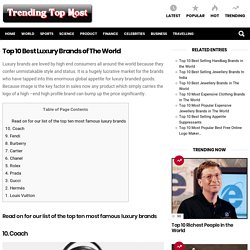
It is a hugely lucrative market for the brands who have tapped into this enormous global appetite for luxury branded goods. Because image is the key factor in sales now any product which simply carries the logo of a high –end high profile brand can bump up the price significantly. At number ten is the famous American luxury brand, Coach which has a total value of $3.2 Billion. Luxury Market Growth In 2017? Keep Your Expectations Low. Illuminating Best Practices in Luxury Brand Marketing. Luxury Brands Are Realizing the Impact of Digital Engagement. In the past, luxury brands have relied on traditional marketing channels such as print and direct mail to engage their high-value audiences.
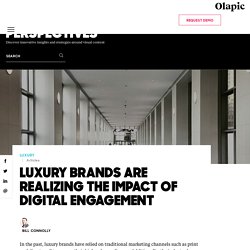
Additionally, the industry has placed an enormous focus on the in-store experience, as an opportunity to differentiate through enhanced service, upscale decor, and personalization. Given this history, it is understandable that luxury brands have largely trailed other verticals in adopting true digital strategies, hesitant to cede control of their messaging.
In fact, according to Bain & Company, 40 percent of high-end brands still do not sell via the Web. Recently, Paul Vallois, managing partner at Cocoon London wrote about the emerging value of digital in an article for Luxury Daily. In it, he lays out a case for intelligent digital strategy that will allow luxury brands to retain the high-end personality while still taking advantage of digital channels to engage and convert. Research: Luxury Brands Are Beginning to Embrace Customer Content. In order to succeed, luxury brands must reflect a specific and aspirational lifestyle to their audiences.

Perhaps more than any other consumer-facing industry, marketers in the luxury vertical have traditionally maintained a firm grasp on brand messaging and positioning. As a result of technological innovation and the proliferation of social networks, however, luxury brands have had to rethink their preferred strategies. More often, they are involving their audiences directly in marketing campaigns, and taking a collaborative approach to consumer engagement. As more than 75 million digitally-native millennials enter their prime as consumers, the industry has reached a critical inflection point, and brands that are able to adapt and effectively connect with customers will realize success now and long into the future.
3 Trends Luxury Brands Must Consider in 2017. Luxury brands have understandably maintained tight control over their messaging and brand identities.

In an industry largely defined by traditional relationships, and the cultivated quality of products and services, luxury brands have been more gradual in the adoption of emerging consumer technology and social platforms. For this reason, monitoring the luxury vertical can be a good indicator of the maturity of various trends. Today, consumer behaviors are being disrupted by mobile devices and a desire for more personalized brand experiences. Marc Jacobs heads off rumours of decline by revisiting former glories. That rumours of the artistic demise of the New York fashion week legend Marc Jacobs had been vastly exaggerated was evident when Anna Wintour broke into a run on Park Avenue to make sure she arrived on time for the start of Jacobs’ show.

Even the US Vogue editor-in-chief, peerless in her power over the city’s fashion scene, could not afford to miss this. Last month, Jacobs addressed persistent rumours that his label was in financial difficulties, telling Women’s Wear Daily there was no truth in gossip that he was set to hand over creative control, and adding that the talk was “upsetting and stressful” to his staff. His show on Wednesday – rumoured to be in danger of being cancelled – went ahead, and to a full house which included Nicki Minaj and Raf Simons, designer at that other Manhattan fashion institution, Calvin Klein. A long, single row of folding chairs were lined up around the Park Avenue Armory. Two minutes after the stated 6pm start time, the show began in silence. Mulberry luxury goods maker sees profit treble. Image copyright Getty Images Luxury goods company Mulberry sees profits treble following switch to focus on more affordable products.
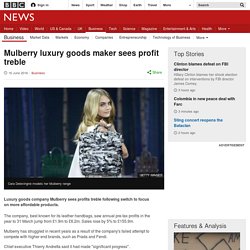
The company, best known for its leather handbags, saw annual pre-tax profits in the year to 31 March jump from £1.9m to £6.2m. Prada seeks younger customers in bid for growth. Image copyright AP Italian luxury fashion group Prada has predicted a return to growth as it seeks to connect with younger customers through online sales and flexible pricing.
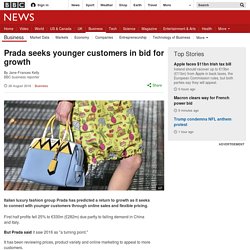
First half profits fell 25% to €330m (£282m) due partly to falling demand in China and Italy. But Prada said it saw 2016 as "a turning point. " It has been reviewing prices, product variety and online marketing to appeal to more customers. Burberry New London Fashion Week Home. Picture credit: Burberry/Mario Testino 16 August 2016 Katie Berrington BURBERRY is bidding farewell to its Kensington Gardens base for the forthcoming show on September 19, the brand has revealed this morning.

Moving closer to the London Fashion Week hub in Soho's Brewer Street Car Park - where the official show space has been located for the past two seasons - the luxury British brand's new venue, named "Makers House", is situated at 1 Manette Street. Related Show. Louis Vuitton Targets Middle-Income Shoppers With Perfume Launch. PARIS, France — Louis Vuitton has launched its first perfume range since the founding merger of its parent LVMH in 1987, targeting middle-income shoppers amid a downturn in luxury spending.
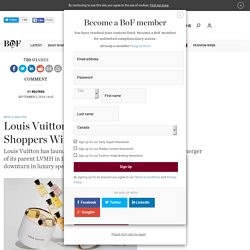
This week's launch is an important step for the French brand as it tries to strike the delicate balance between increasing its number of more affordable goods while retaining its cachet. Until now, shoppers on more modest incomes have only been catered for by Louis Vuitton's key chains and very small leather goods, costing around €200-300 a piece.
But the brand needs to boost sales growth after a sharp slowdown in the past three years, and with little sign of an industry recovery as security fears and geo-political uncertainty hit the tourism flows vital for luxury brands. Getting consumers to buy luxury products on Amazon.com. NEW YORK, United States — In 2012, Amazon debuted its first fashion advertisement. It was reminiscent of an American Vogue spread and featured a dolled up Chanel Iman in a taut, alert pose. Printed across her shins was the phrase “Smart is Beautiful,” a tagline still employed by the glossiest division of the e-commerce and cloud computing giant, which generated combined revenues of $107 billion in 2015. Over the past five years, Amazon has made a series of moves aimed at the fashion market that go far beyond print advertising.
Luxury brands get tougher with counterfeiters — and Alibaba.